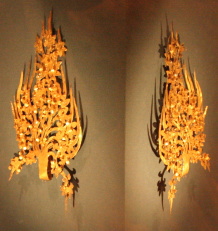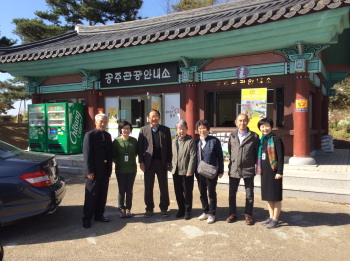 |
Information Center of Gongju City.
Our friend Mrs. Song works here. Her fluent Japanese, abundant knowledge
of history, and above all, her warm, loving heart make the visitors feel
happy.
We met other old friends too. |
(From Wikipedia)
The Tomb of King Muryeong, also known as Songsan-ri Tomb No. 7 (공주 송산리 7호분), is the ancient tumulus of King Muryeong, who ruled the Baekje Kingdom from 501 to 523, and his queen. The rarity of intact Baekje tombs makes this one of the major archaeological discoveries in Korea and a crucial source for the understanding of Baekje, one of the Three Kingdoms.[1]
The tomb is located in present-day Gongju in Chungcheongnam-do, South Korea. It is Korean Historic Site No.13. King Muryeong's Tomb is also registered on the South Korean government's tentative list of World Heritage Sites.
|
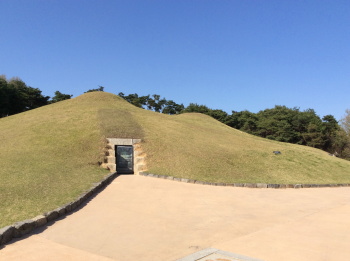 |
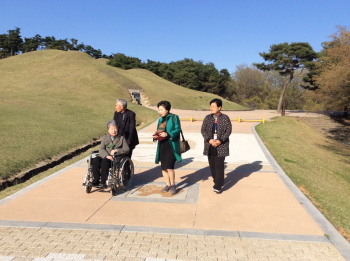 |
Mr. Song, another friend, kindly pushed my wheel-chair.
I said I could walk, but he did.
It was too kind of him. I know how heavy I am.
My husband was a busy photographer.
|
Welcome party was prepared for us.
A famous eel restaurant.
We say in Korean language, "Massisoyo" that means "tasty". |
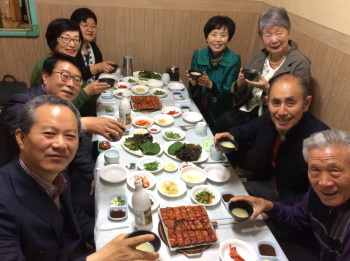 |
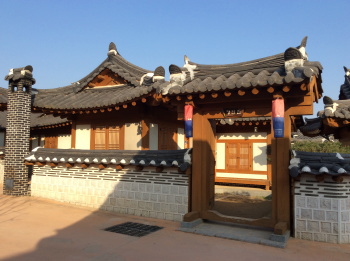 |
Our hotel, prepared by our friends, was a Korean style house, "Hanok".
Here, many new Hanoks were built after Gongju City was resignated as World
Heritage.
Our house had two rooms for sleeping, one living room, and toilet and shower.
The floor was heated, and I could not sleep on a too hot floor. Next morning, I found that the color of the part of the floor on which I laid my mattress was darker than other part, and I knew the reason. I was sleeping on the hottest part of the floor! I should have moved a little away. |
Gongsanseong Fortress of Baekje
Baekje Historic Areas
(from UNESCO HERITAGE LIST)
Located in the mountainous mid-western region of the Republic of Korea, this property comprises eight archaeological sites dating from 475 to 660 CE, including the Gongsanseong fortress and royal tombs at Songsan-ri related to the capital, Ungjin (present day Gongju), the Busosanseong Fortress and Gwanbuk-ri administrative buildings, the Jeongnimsa Temple, the royal tombs in Neungsan-ri and the Naseong city wall related to the capital, Sabi (now Buyeo), the royal palace at Wanggung-ri and the Mireuksa Temple in Iksan related to the secondary Sabi capital. Together, these sites represent the later period of the Baekje Kingdom – one of the three earliest kingdoms on the Korean peninsula (18 BCE to 660 CE) - during which time they were at the crossroads of considerable technological, religious (Buddhist), cultural and artistic exchanges between the ancient East Asian kingdoms in Korea, China and Japan.
|
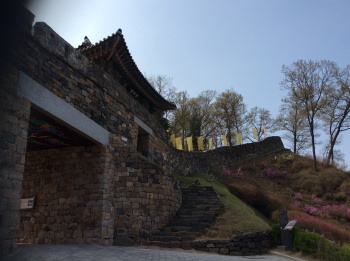 |
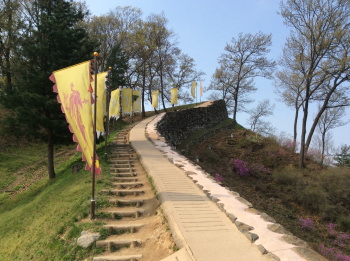 |
On the stone walls, there is a pass around the fortress..
How I wished to walk along it. But everybody stopped me. My aching knees
made me give up my ambition to conquer this fortress.
|
Up the hill, it was a paradise of cherry blossoms in full bloom.
My husband is under the cherry blossoms.
You can see how tall the trees are, |
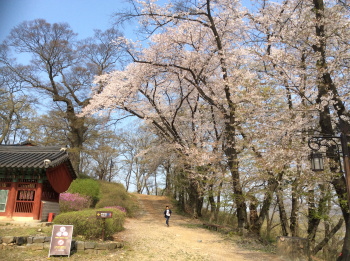 |
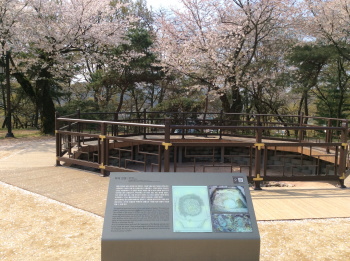 |
On top of the hill, there is an ancient pond.
Rain water is stored in this pond for an emergency of fire, or enemy attacks. |
|
In 1971, King Muryeong's tomb was excavated in Songsan-ri, Gongju, South Korea, where he was buried with his queen.
In 2001, Japan's emperor Akihito told reporters "I, on my part, feel a certain kinship with Korea, given the fact that it is recorded in the Chronicles of Japan that the mother of Emperor Kanmu was of the line of King Muryeong of Baekje."
It was the first time that a Japanese emperor publicly acknowledged Korean
blood in the imperial line.[3] According to the Shoku Nihongi, Emperor Kanmu's mother, Takano no Niigasa is a descendant of Prince Junda, son of Muryeong, who died in Japan in 513 (Nihon Shoki Chapter 17).
|
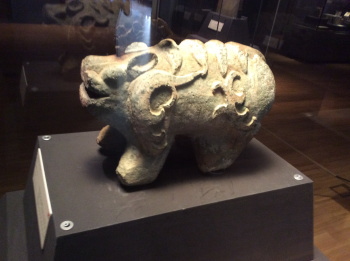
Korean National Treasure Stone Guardian of the Tomb |
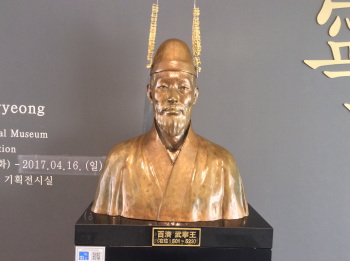 |
Muryeong of Baekje (462–523, r. 501–23) was the 25th king of Baekje, one of the Three Kingdoms of Korea. During his reign, Baekje remained allied with Silla against Goguryeo, and expanded its relationships with China and Japan.
|
This King was born in Kakara-shima, a small island off shore of Karatsu.
This description appears in Japan's second oldest chronicles, Nihon Shoki,
published in the 8th century.
On the side of Korea, this history was long ignored. But by the discovery
of the memorial tablets from the King's tomb, now it is considered to be
a fact.
The main reason why I wanted to visit Gongju was this fact that the King
was born in Karatsu 1500 years ago. |
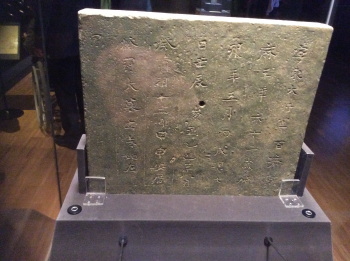
Korean National Treasure Buried Memorial Tablet |
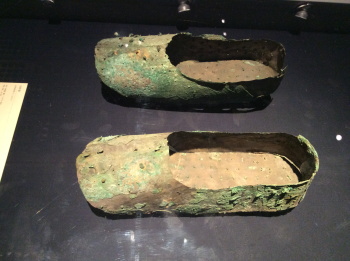 |
The gilt-bronze shoes of King and Queen.
King was described to be very tall, over 8 feet!.
King's shoes are big, 40cm long.
These shoes have spikes, of which reason is a mistery.
Queen's shoes have beads decoration.
|
Gongju was in full bloom.
In spite of the terrible threat of North Korea, people looked happy under
the beautiful cherry blossoms.
Festival was held, people eat and drink and sing, blossom petals dancing
in the soft breezes, and time seemed to stop.
I prayed. Please do not let bad things happen on this beautiful earth. |
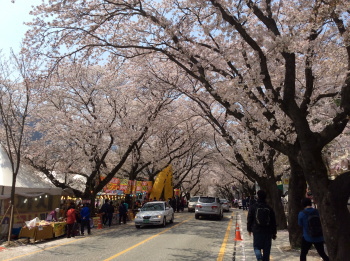 |
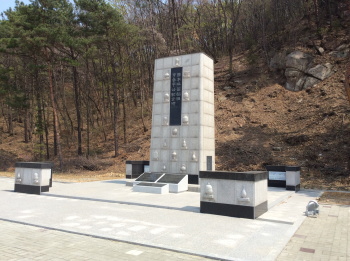 |
We visited the monument of Yi Sam-Pyeong.
Yi Sam-Pyeong is thought to be the Father of Arita Porcelain in Saga, Kyushu, Japan.
In Arita, there is a similar monument.
According to some scholar's study, Yi was from this part of Korea.So people
of Arita came here and built this monument. Originally, it was built at
another spot, but the road construction forced it to move here. It was
re-built, so this is a quite new monument,
We went to see the old one, but there was no road to go near it anymore.
We glanced from far away among dense trees.
400 years is a long time that chases many histories away from our memoy.
In Arita, the big monument is well reserved and every year people have
a festival to remember Yi Sam-Pyeong. |
Professor Cheong and his sweet wife Song are our friends, and they
were the kind hosts who invited us to this fantastic city of history.
Thank you so much. We had not enough time to see all of this historic site.
We must go again. Next time I will walk on my own legs. |
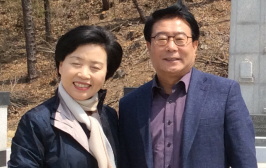 |
|

